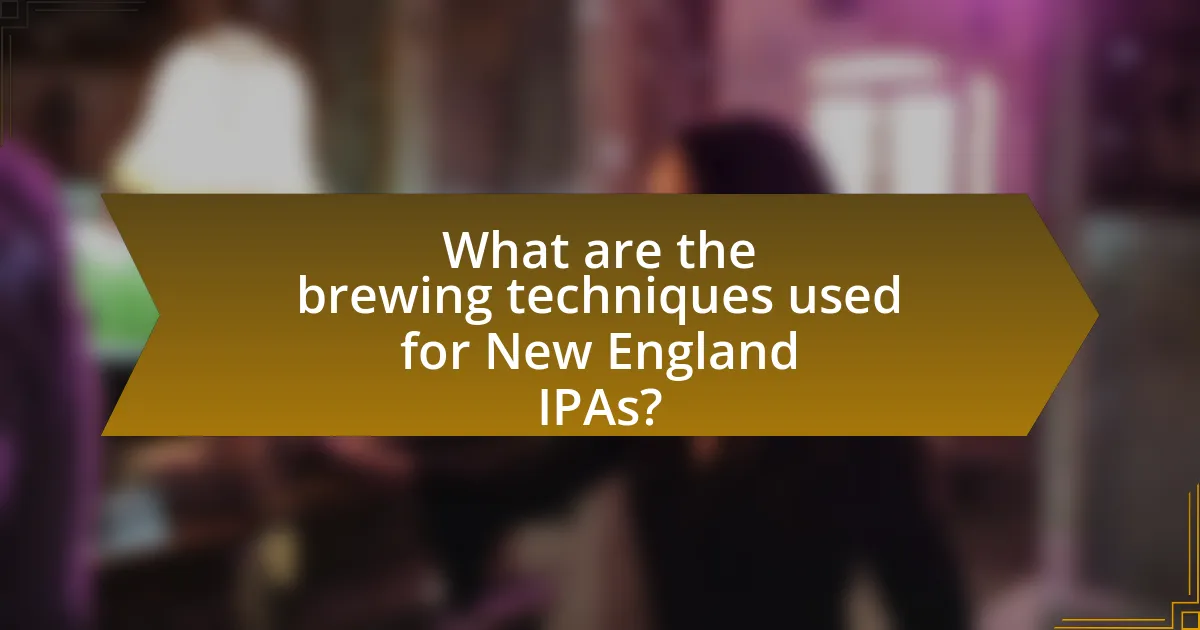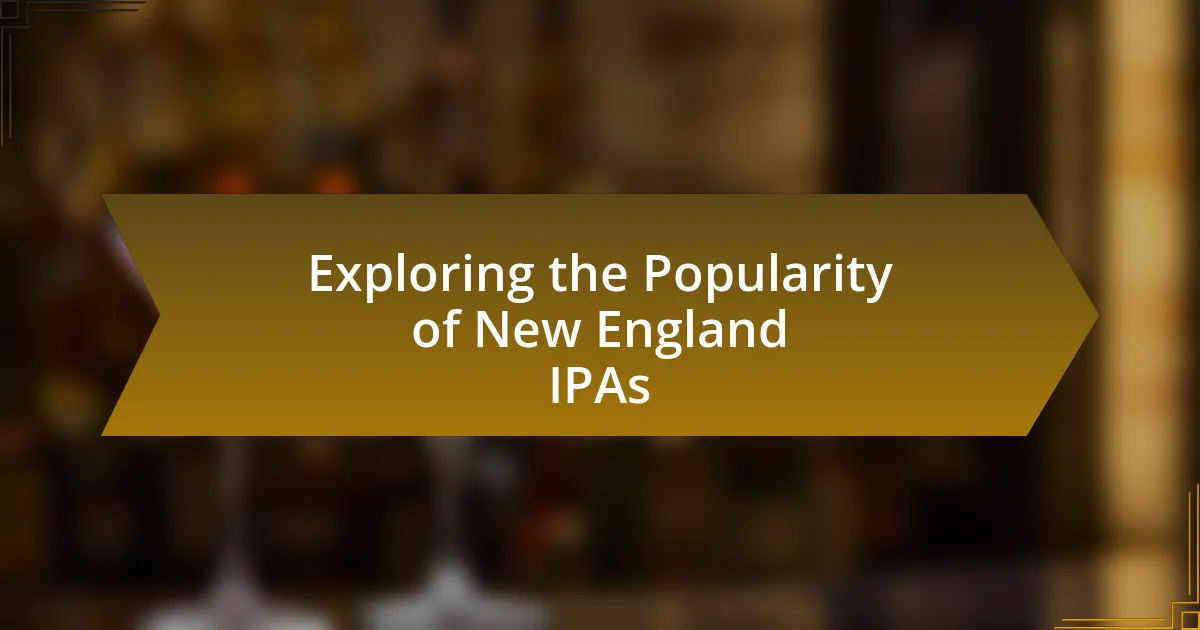New England IPAs, also known as Hazy IPAs, are a popular style of India Pale Ale distinguished by their hazy appearance, juicy flavor profile, and low bitterness. This article explores the characteristics that define New England IPAs, including their brewing techniques, unique ingredients, and the demographic trends among their drinkers. It also examines the factors contributing to their rise in popularity, such as the craft beer movement, social media marketing, and evolving consumer preferences. Additionally, the article discusses future trends in brewing and consumer choices, highlighting the impact of New England IPAs on the craft beer industry.

What are New England IPAs and why are they popular?
New England IPAs, also known as Hazy IPAs, are a style of India Pale Ale characterized by their hazy appearance, juicy flavor profile, and low bitterness. This style became popular due to its emphasis on hop aroma and flavor, often featuring tropical fruit notes like mango and pineapple, which appeal to a wide range of beer drinkers. The brewing process typically involves late hop additions and dry hopping, which enhances the aromatic qualities while minimizing bitterness. The popularity of New England IPAs has surged since the mid-2010s, with breweries across the United States producing their own versions, contributing to a significant increase in craft beer sales and consumer interest in innovative brewing techniques.
How do New England IPAs differ from other IPA styles?
New England IPAs differ from other IPA styles primarily in their hazy appearance and juicy, fruity flavor profile. Unlike traditional IPAs, which often emphasize bitterness from hops, New England IPAs focus on a softer mouthfeel and a more aromatic, tropical fruit character due to the use of specific hop varieties and late hopping techniques. This style typically employs a higher proportion of oats and wheat in the grain bill, contributing to the haze and creamy texture. Additionally, New England IPAs are often less bitter, with an average International Bitterness Units (IBU) range of 30-50, compared to the 40-70 IBU range commonly found in West Coast IPAs.
What unique characteristics define New England IPAs?
New England IPAs are characterized by their hazy appearance, juicy flavor profile, and low bitterness. The haziness results from the use of specific grains, such as oats and wheat, which contribute to a smooth mouthfeel. Juicy flavors are achieved through the use of late hop additions and dry hopping, often featuring tropical fruit notes like mango and pineapple. Additionally, New England IPAs typically have an ABV ranging from 6% to 8%, making them approachable yet flavorful. The low bitterness is a result of the brewing technique that emphasizes hop aroma and flavor over bitterness, distinguishing them from traditional IPAs.
Why do these characteristics appeal to craft beer drinkers?
The characteristics of New England IPAs appeal to craft beer drinkers due to their unique flavor profiles, hazy appearance, and emphasis on hop aroma. These attributes create a sensory experience that differentiates them from traditional beers, attracting consumers seeking innovation and variety. The haziness, often resulting from the use of specific grains and yeast, enhances mouthfeel and visual appeal, while the juicy, fruity hop flavors cater to modern palates that favor less bitterness. According to a 2021 Brewers Association report, New England IPAs accounted for over 25% of the craft beer market, underscoring their popularity and the demand for distinctive craft offerings.
What factors contribute to the rise in popularity of New England IPAs?
The rise in popularity of New England IPAs is primarily driven by their unique flavor profile, which emphasizes juicy, fruity hop characteristics and a hazy appearance. This style appeals to consumers seeking a more approachable and less bitter alternative to traditional IPAs. Additionally, the craft beer movement has fostered a culture of experimentation, encouraging brewers to innovate with hop varieties and brewing techniques that enhance aroma and flavor. The increasing availability of New England IPAs in both local breweries and retail outlets further supports their popularity, as consumers have greater access to these distinctive brews.
How has the craft beer movement influenced their popularity?
The craft beer movement has significantly influenced the popularity of New England IPAs by promoting unique flavors and local brewing practices. This movement has led to an increase in consumer interest in diverse beer styles, particularly those that emphasize hop-forward profiles and hazy appearances, which are characteristic of New England IPAs. According to the Brewers Association, craft beer sales grew by 21% in 2020, indicating a strong consumer shift towards craft options, including New England IPAs. This growth is further supported by the rise of microbreweries and brewpubs, which have made these styles more accessible to a wider audience, thereby enhancing their popularity.
What role do social media and marketing play in their success?
Social media and marketing are crucial for the success of New England IPAs as they enhance brand visibility and consumer engagement. These platforms allow breweries to showcase their unique offerings, share brewing processes, and connect with a broader audience. For instance, a study by the Brewers Association found that 70% of craft beer consumers discover new brands through social media. Additionally, targeted marketing campaigns can effectively reach specific demographics, driving sales and fostering community around the product. This strategic use of social media and marketing not only boosts sales but also cultivates brand loyalty among consumers.
What demographic trends are associated with New England IPA drinkers?
New England IPA drinkers tend to be predominantly younger adults, particularly those aged 21 to 35. This demographic trend is supported by market research indicating that craft beer, including New England IPAs, is most popular among millennials and Generation Z. Additionally, studies show that these drinkers often have higher levels of education and disposable income, which correlates with their preference for craft beer styles that emphasize unique flavors and brewing techniques.
Which age groups are most likely to prefer New England IPAs?
Individuals aged 25 to 34 are most likely to prefer New England IPAs. This preference is supported by market research indicating that younger adults, particularly millennials, are driving the craft beer movement, with New England IPAs being a popular choice due to their hazy appearance and juicy flavor profile. According to a 2021 survey by the Brewers Association, 60% of craft beer drinkers in this age group reported a preference for hazy IPAs, which include New England styles.
How does gender influence the consumption of New England IPAs?
Gender influences the consumption of New England IPAs by affecting preferences and purchasing behaviors, with studies indicating that women are increasingly embracing craft beers, including IPAs. Research shows that women often prefer fruitier and hazy styles, which are characteristic of New England IPAs, leading to a growing market segment. According to the Brewers Association, women accounted for 27% of craft beer drinkers in 2020, a significant increase from previous years, highlighting a shift in gender dynamics within the craft beer industry. This trend suggests that gender not only shapes taste preferences but also impacts the overall growth and popularity of New England IPAs.

What are the brewing techniques used for New England IPAs?
New England IPAs are brewed using techniques that emphasize hop flavor and aroma while minimizing bitterness. Key techniques include late hopping, where hops are added during the last stages of the boil or after fermentation, and dry hopping, which involves adding hops during fermentation to enhance aroma without increasing bitterness. Additionally, the use of high-protein grains like oats and wheat contributes to the hazy appearance and mouthfeel characteristic of New England IPAs. These methods collectively create a juicy, fruity profile that distinguishes New England IPAs from other styles.
How does the brewing process differ for New England IPAs compared to traditional IPAs?
The brewing process for New England IPAs (NEIPAs) differs from traditional IPAs primarily in the use of hops and the timing of their addition. NEIPAs emphasize late hop additions and dry hopping during fermentation, which enhances aroma and flavor while minimizing bitterness. In contrast, traditional IPAs often incorporate hops earlier in the boil, resulting in a more pronounced bitterness. This method in NEIPAs contributes to their characteristic hazy appearance and juicy flavor profile, which is supported by the use of specific grains like oats and wheat that add to the mouthfeel and cloudiness.
What specific ingredients are commonly used in New England IPAs?
New England IPAs commonly use ingredients such as pale malt, oats, and a variety of hops, particularly those that impart fruity and tropical flavors. Pale malt serves as the base, while oats contribute to the beer’s hazy appearance and smooth mouthfeel. Hops like Citra, Mosaic, and Galaxy are frequently utilized for their aromatic qualities, enhancing the beer’s juicy character. This combination of ingredients is essential in creating the distinctive flavor profile that defines New England IPAs, characterized by their haziness and hop-forward taste.
How does dry hopping affect the flavor profile of New England IPAs?
Dry hopping significantly enhances the flavor profile of New England IPAs by imparting intense hop aromas and flavors without adding bitterness. This technique involves adding hops during the fermentation process, which allows for the extraction of volatile aromatic compounds, such as citrus, tropical fruit, and floral notes, while minimizing the isomerization of alpha acids that contributes to bitterness. Research indicates that dry hopping can increase the perception of hop flavor by up to 50% compared to traditional hopping methods, making it a crucial element in defining the juicy and aromatic characteristics that are hallmark traits of New England IPAs.
What challenges do brewers face when creating New England IPAs?
Brewers face several challenges when creating New England IPAs, primarily related to achieving the desired hazy appearance and juicy flavor profile. The use of specific hops, such as late-addition and dry-hopping techniques, can lead to issues with hop utilization and potential over-extraction of undesirable flavors. Additionally, the high protein content from certain grains, like oats and wheat, can complicate the brewing process by affecting clarity and stability. Maintaining a balance between hop aroma and bitterness is also crucial, as New England IPAs are known for their low bitterness yet intense hop character. These challenges require careful recipe formulation and brewing techniques to ensure the final product meets consumer expectations for this popular style.
How do brewers maintain consistency in flavor and aroma?
Brewers maintain consistency in flavor and aroma by implementing standardized brewing processes and using precise measurements of ingredients. This includes controlling variables such as water chemistry, fermentation temperature, and yeast strains, which directly influence the final product’s taste and smell. For example, many brewers utilize specific hop varieties known for their distinct aromatic profiles, ensuring that each batch delivers a similar sensory experience. Additionally, regular quality control testing, including sensory evaluations and chemical analyses, helps brewers identify any deviations from desired flavor and aroma characteristics, allowing for adjustments in future batches.
What are the common pitfalls in brewing New England IPAs?
Common pitfalls in brewing New England IPAs include inadequate hop utilization, poor yeast management, and insufficient haze stability. Inadequate hop utilization can lead to a lack of the desired juicy and fruity flavors, which are characteristic of this style. Poor yeast management, such as not controlling fermentation temperatures, can result in off-flavors that detract from the beer’s profile. Insufficient haze stability often arises from improper protein and polyphenol interactions, leading to a less appealing appearance and mouthfeel. These factors can significantly impact the overall quality and acceptance of the New England IPA among consumers.

What are the future trends for New England IPAs?
Future trends for New England IPAs include an increased focus on hop diversity, innovative brewing techniques, and sustainability practices. Breweries are likely to experiment with a wider range of hop varieties, moving beyond traditional choices to include unique and lesser-known hops that can enhance flavor profiles. Additionally, advancements in brewing technology, such as improved fermentation methods and dry hopping techniques, will continue to evolve the style, allowing for more complex and aromatic beers. Sustainability will also play a crucial role, with breweries adopting eco-friendly practices, such as sourcing local ingredients and reducing water usage, to appeal to environmentally conscious consumers. These trends are supported by market research indicating a growing consumer preference for unique flavors and sustainable products in the craft beer sector.
How are consumer preferences evolving in the craft beer market?
Consumer preferences in the craft beer market are increasingly shifting towards unique flavors and local sourcing, with a notable rise in demand for New England IPAs. This evolution is evidenced by a 2022 report from the Brewers Association, which indicated that New England IPAs accounted for over 25% of the craft beer market share, reflecting consumers’ desire for hazy, juicy, and aromatic beers. Additionally, surveys show that 60% of craft beer drinkers prioritize innovative brewing techniques and local ingredients, further highlighting the trend towards artisanal and distinctive offerings in the craft beer segment.
What innovations are being introduced in New England IPA recipes?
Innovations in New England IPA recipes include the use of new hop varieties, techniques like dry hopping during fermentation, and the incorporation of adjuncts such as oats and wheat for enhanced mouthfeel. These advancements aim to create a juicier, hazier beer profile that emphasizes tropical and citrus flavors. For instance, the introduction of hops like Sabro and Strata has contributed unique flavor profiles, while the practice of biotransformation during fermentation has been shown to enhance hop character, as evidenced by studies on hop utilization in brewing.
How might the popularity of New England IPAs impact the craft beer industry?
The popularity of New England IPAs is likely to significantly influence the craft beer industry by driving innovation and increasing competition among breweries. As consumer demand for these hazy, hop-forward beers rises, breweries may invest more in developing similar styles, leading to a broader range of offerings. According to the Brewers Association, New England IPAs accounted for over 25% of the IPA market share in 2021, illustrating their substantial impact on consumer preferences. This trend encourages craft breweries to experiment with new ingredients and brewing techniques, ultimately enhancing the diversity and creativity within the craft beer sector.
What tips can consumers consider when choosing New England IPAs?
When choosing New England IPAs, consumers should prioritize freshness, as these beers are best enjoyed within a few weeks of packaging to maintain their hop aroma and flavor. Additionally, consumers should consider the haze level, which is a characteristic feature of New England IPAs, indicating a juicy and fruity profile. Checking the ABV (alcohol by volume) is also important, as it typically ranges from 6% to 8%, influencing the beer’s strength and overall experience. Lastly, reading reviews and seeking recommendations can help consumers identify high-quality options, as many breweries produce variations that may appeal to different palates.
How can one identify high-quality New England IPAs?
To identify high-quality New England IPAs, one should look for a hazy appearance, a strong hop aroma, and a balanced flavor profile that includes fruity and juicy notes. High-quality examples typically exhibit a smooth mouthfeel and low bitterness, which is achieved through specific brewing techniques such as dry hopping. Additionally, reputable breweries often provide detailed information about their ingredients and brewing process, which can serve as indicators of quality. The presence of fresh hops, particularly varieties like Citra, Mosaic, and Galaxy, is also a hallmark of well-crafted New England IPAs.
What food pairings work best with New England IPAs?
New England IPAs pair best with spicy foods, seafood, and rich cheeses. The fruity and hoppy characteristics of New England IPAs complement the heat of spicy dishes, such as Thai or Indian cuisine, by balancing flavors. Additionally, the citrus notes in these IPAs enhance the taste of seafood, particularly grilled fish and shrimp, making them an excellent match. Rich cheeses, like brie or gouda, also work well, as their creaminess contrasts with the beer’s bitterness, creating a harmonious tasting experience.
